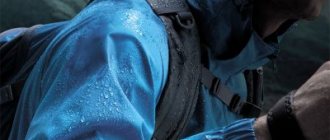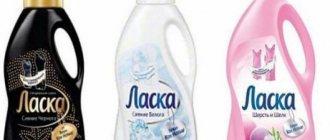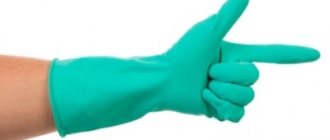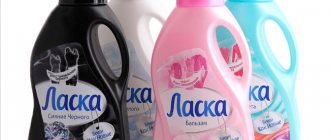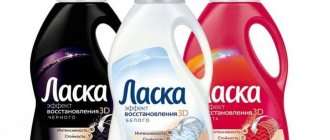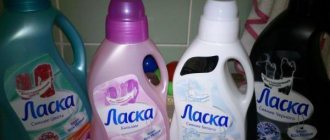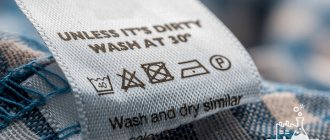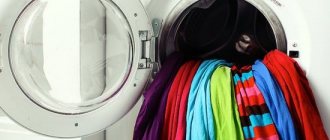New technologies, used, among other things, by clothing manufacturers, make it possible to produce products with maximum functionality. To provide greater comfort to adults and children, membrane materials are now widely used, which have recently been used only by those who need equipment for extreme conditions. When caring for such clothes, it is necessary to take into account some subtleties.
Detergent for washing membrane clothes
What is membrane clothing
The emergence of membrane products is an example of how high-tech developments find application in the national economy. Clothing companies use functional fabrics in the production of clothing. The main advantage of membranes is protection against moisture penetration from the outside, resistance to wind and the ability to pass steam escaping from the inside.
Membrane clothing
Manufacturers produce clothes from three types of material.
- Fabrics without pores, covered with a film that does not allow moisture to pass through. The peculiarity of the membrane is that it does not allow water to pass through, and any types of contamination of the outer layer do not lead to a deterioration in vapor permeability.
- Porous membranes consisting of micropores. Water molecules do not penetrate through such holes and steam is easily released outside. But when the pores are blocked, for example, in the case of soiled clothing, the breathability of the material deteriorates significantly.
- Combined materials that are considered the most technologically advanced. In such products, the outer coating has no pores, while inside there is a porous layer.
Layered membrane fabric
Membrane clothing allows you to feel comfortable in any weather and during any physical activity, providing the necessary microclimate. This is especially sensitive for children who are used to spending time on the move. In this case, it is very important that the resulting sweat can escape freely, since otherwise a wet layer forms on the skin, which becomes cold when at rest. Membranes help prevent this problem, allowing you to feel good in any condition and in any weather.
How to wear membrane clothing
What are the benefits of membrane materials:
- they maintain a constant temperature that is comfortable for the body, regardless of environmental parameters;
- lightness and small volume of clothing allow you to move freely;
- there is no need to purchase several sets of clothing in case of contamination, since caring for membrane sets is simple and does not require lengthy activities.
Important! Under the membrane you should wear clothes made of synthetics or combined materials. In this case, sets made of cotton fabric are contraindicated, since it is hygroscopic and absorbs sweat well, which can lead to hypothermia. It is recommended to use thermal underwear.
Thermal underwear
The disadvantages of membranes include their fragility (after twenty washes, most fabrics lose a fifth of their thickness, regardless of the type of wash), high cost and the need for careful care.
Video - Membrane breathable fabrics
Weasel Shine of Color
This is the name of the product intended for colored laundry. As the name suggests, the product not only preserves, but also refreshes colors. According to reviews, this is true:
- Items washed by “Laska” retain their color well.
- The downside is the same as for white clothes - the washing ability is not good enough.
- The product dissolves well in water, and there are no problems with rinsing.
An alternative to “Color Shine” is “Color Magic”:
- It also focuses on keeping fabric colors bright and rich.
- You can also use “magic” to work with delicate things, which as a result return the appearance as close as possible to the original.
Rules for caring for membrane models
To ensure that clothes do not lose their performance and external characteristics over a long period of time, it is enough to follow simple rules. This is important, since the material is quite expensive and it would be a shame to accidentally spoil it with incorrect actions.
- Each product comes with instructions, which we recommend you read carefully.
Instructions are not always in Russian - Clothes are washed by hand or in a washing machine. In this case, it is important to use a delicate mode, which involves maintaining the temperature at about 30 degrees and using products specially designed for this. If you wash at temperatures above 40 degrees, there is a high probability of the pores of the material sticking together.
- Before washing clothes, you must turn the item inside out and then fasten the existing zippers.
- Frequent washing of the membrane is not required, as it repels dirt. You can simply wash off the stain without thoroughly treating the entire product by using a sponge and running the problem area under running water.
Some manufacturers allow membrane items to be washed in a washing machine on a delicate cycle, while others categorically recommend hand washing only. - Before placing clothes in water, remove dirt with a brush (being careful not to rub it into the fabric).
- Membrane products are washed without soaking.
- Stain removers, bleaches, powders with active ingredients (for example, chlorine, enzymes) for sports fabrics are not recommended by manufacturers. Even oxygen-containing products are prohibited, as they clog pores. Washing powders with large inclusions are also not acceptable, since such components remain in the pores and are difficult to wash out during rinsing.
When washing, do not use conventional detergents, as they clog the pores of the membrane, reducing its strength and wear resistance. - Softeners typically used for rinsing clothes should not be used on these fabrics.
- For spinning, you can set the washing machine to operate at low speed. Manual spinning is also used, without twisting.
- Membrane clothing should not be hung on heaters to dry. It is recommended to simply straighten it and hang it, or better yet, put it on a wire rack to dry at normal room temperature.
Membrane items should not be wrung out, but should be dried on a horizontal surface. - It is recommended to store membrane clothing in special bags. This will help protect it from dust formation. The storage location should be away from areas where strong odors may form, such as the kitchen. This is due to the increased absorption of any aromas by the membranes.
Features of work
Not many people know, but some types of clothing require special handling due to the nature of their production or the condition of the material. These things include:
- sportswear;
- damaged things.
Washing them in the usual way will not lead to anything good and, most likely, you will soon have to say goodbye to such things. Let's figure out why such things cannot be washed with the rest, and what sequence of actions must be followed.
Sportswear
Sportswear is made using a bunch of modern technologies that increase its thermoregulatory properties and breathability. Regular washing causes significant damage to it, quickly reducing its unique characteristics to nothing.
To avoid this, it is recommended:
- Do not wash sports items with other clothes.
- Powders are not suitable for such fabrics, so it is recommended to use washing gel.
- Do not use fabric softener.
- No bleaching agents.
- It is advisable to use special laundry bags.
- It is not recommended to increase the water temperature above 40 o.
Damaged clothing
When cleaning damaged fabrics, use only washing gels, as powders are much harsher and have a stronger effect on the fabric fibers. If you don’t do this, the item will soon become unusable and you will have to spend money on updating your wardrobe.
What products can you use to wash membranes?
Clothes made from membrane materials should be washed using products recommended by the manufacturers. This will extend its service life and improve performance.
Our usual washing powders are not suitable for caring for membranes. Their particles can clog pores in the material, leading to a deterioration in the moisture removal process. If you need to remove minor dirt, you can use simple laundry soap.
Regular laundry soap for washing membrane clothes
Clothing manufacturers recommend using special formulations suitable for washing membrane materials, which are available in the form of:
- washing powders;
- detergents;
- gels for membranes;
- cleansing balms.
Important! Frequent washing of the membrane is not recommended. It leads to the gradual washing away of the water-repellent impregnation of the fabric. But you can’t wash clothes less than once a year. For care, use only products that indicate that they are suitable for use on membrane products.
Frequent washing of the membrane is not recommended.
Several compositions are offered that allow you to maintain the functionality and attractiveness of the products.
- Nikwax Tech Wash. This product can be used on all types of clothing except those that use down. The liquid perfectly removes any type of dirt, including old dirt. It penetrates into the structure of the material and perfectly preserves all its qualities, including breathability and resistance to moisture. If other detergents were previously used for washing, their residues in the fabric are easily removed, which allows you to restore the properties of the membrane that were lost because of this. Before using the composition, use a brush to clean heavy dirt. In case of hand washing, at least three rinses must be used.
Nikwax Tech Wash In conclusion, to restore the water-repellent layer, the impregnation of the same manufacturer Nikwax TX.Direct Wash-In is effective.
Nikwax TX.Direct Wash-In - Perwoll Sport & Active. The product has a pleasant aroma and is intended for washing sportswear. It washes well, especially when pre-soaked (for 40 minutes), and has a fresh smell. The composition is endowed with the ability to remove difficult-to-remove stains, such as grease stains.
Perwoll Sport & Active - Denkmit Fresh Sensation. A gel with a jelly-like consistency or a capsule composition penetrates deeply into the fabric structure and removes dirt well. Their components help eliminate unpleasant odors. After treatment, the product also protects the material from absorbing odors.
Denkmit Fresh Sensation - DOMAL Sport Fein Fashion. German balsam is used as an independent detergent for washing sportswear and shoes. The composition is used sparingly, does not leave streaks, and pleasantly scents things.
DOMAL Sport Fein Fashion - Woly Sport. The shampoo is designed to care for all types of climate membranes. The product is quite expensive, but according to some consumers, it does not always remove stains efficiently. Most often, complaints are caused by the composition produced in the Russian Federation (there are few complaints about the German one). On average, a package is enough for 10 washes.
Woly Sport Down & Wool Wash - SALTON Sport . The gel penetrates deeply into the fibers of the fabric, carefully eliminating dirt and unpleasant odors. After using the composition, the membrane does not lose its breathable properties, the fabric retains its elasticity without losing its shape. Despite the budget cost of the product, there is a significant drawback - due to the high consumption, it does not last long. One bottle is designed for no more than three washes. Many people note a pungent odor that does not dissipate over time.
Table. Liquid products for removing stains from membrane clothing.
| Cleaning agent | Volume, ml | Application |
| Nikwax Tech Wash | 300, 1000 | For washing in hard water you need 3 caps (150 ml), in soft water - 2. |
| Perwoll Sport & Active | 1000 | To clean things manually you will need 60...120 ml of shampoo, for machine processing: 75...135 ml. |
| Denkmit Fresh Sensation | 1500, capsules | Used for washing at temperatures of 20...40 degrees. On average, one package is enough for 35 washes (depending on the condition of the clothes). |
| DOMAL Sport Fein Fashion | 750 | Washing is carried out in warm water (30 degrees). Consumption for manual processing of clothes: 1/2 cap per 5 liters of water, for machine processing - depending on the degree of contamination: from 2 to 3 caps per 2.5 kg of products. |
| Woly Sport | 250 | Consumption rates: for hand washing - 1 cap per 5...10 liters of water, for machine washing - from 1 to 2 caps. |
| SALTON Sport | 250 | One wash requires from 75 to 150 ml of shampoo (depending on the condition of the membrane and the degree of water hardness). |
Varieties of gel and powder forms
Laska washing gel
“Laska” is available in several versions, so to achieve maximum effect it is worth clearly defining the purpose of use in advance.
"Black Magic"
This variety of “Laski” allows you not only to remove dirt, but also to preserve the intensity of the main color, restores the richness and depth of shades, and gives the product a well-groomed appearance.
The effect is achieved by removing the pellets that appear during the wearing of the product. Their presence gives black clothes a faded and uncharacteristic gray appearance.
"White Glow"
This series helps restore snow-whiteness to gray and yellowed white products. Most effective against fresh stains. "White Glow" smoothes the surface of the material, which enhances the reflection of color.
"Color Shine"
This product prevents dyes from being washed out of colored fabrics.
Protecting the shade of a thing goes in three main directions:
- saturation protection;
- maintaining contrast and shine;
- smoothing out roughness.
Regular use of Color Shine preserves the appearance of the product throughout its entire service life.
For wool and delicate fabrics
The series with bamboo extract provides gentle care for delicate fabrics and wool. Regular use of this series of products allows you to give your clothes tenderness, softness and elasticity.
Suitable for use with the following materials:
- llama wool;
- viscose;
- silk;
- fluff;
- sheep wool;
- mohair;
- cashmere.
For sportswear
This “Weasel” helps to preserve the properties of the membranes and fibers of the material without changes, eliminate the smell of sweat and prevent its reappearance after active sports.
Read more ► Phosphate-free powders for children, rating of the best and names of manufacturers
Active & Fresh is recommended for use on the following fabrics:
- cotton;
- spandex;
- fleece;
- membrane material;
- microfiber;
- polyamide;
- polyester.
Washing technology
Membrane products can be washed using two methods.
- Manual method. Washing is carried out using the listed compositions or ordinary laundry soap (grated and diluted in water). It is also allowed to use baby soap. Unless the instructions provide for other actions, the sequence of the activity involves treating the wetted surface of contaminated areas with a prepared product (dissolved in water). It is recommended to use a sponge for this. After standing for a quarter of an hour, the clothes are washed and rinsed in clean water (temperature about 30 degrees). If the effect does not live up to expectations, you need to wash it again.
Manual method - Machine washable. In this case, gentle technology is used. It is important to proceed with caution as there is a high risk of damage to the membrane. To achieve a greater effect, it is recommended to pre-wash the contaminated areas by hand. The delicate washing mode is set (for example, suitable for woolen products), the water temperature is within 30...40 degrees. Some units use separate programs for the care of membrane clothing. You can put a couple of tennis balls (or specially designed laundry equipment) in the drum to prevent clumping. It is recommended to do several, two or three rinses. The product should not be spinned.
Machine washable
After any type of washing, the remaining moisture is squeezed out manually, without twisting the clothes. You can remove excess water by squeezing the item in several places. You can also use a cotton towel to wrap around the wet item. A terry robe is also suitable for these purposes. After a gentle spin, the product is straightened and laid out on a horizontal area. The room must be ventilated. It is important to make sure that the sun's rays do not reach your clothes.
Things are dried flat on horizontal surfaces
As already noted, heating devices cannot be used to dry membrane products. You should also not iron them. This may damage the membrane. Special formulations are produced in the form of aerosols, with which you can improve the material’s ability to repel moisture. Manufacturers recommend the use of such products, since over time the water-repellent properties of membranes deteriorate.
Important! Impregnations are used exclusively for treating clean clothes.
Impregnation for membrane fabrics
Numerous attempts to clean contaminated membrane clothing using traditional detergents usually end in failure. After washing, dirt, powder stains, and detergent particles often remain in the pores of the fabric. In addition to external manifestations, the functional qualities of things also deteriorate, their ability to repel water and allow sweat to pass through from the inside. It is recommended not to experiment and choose formulations intended directly for the care of membrane tissues.
Washing liquid "Laska" Active & Fresh
Weasel for white linen
White fabric quickly becomes dirty, and after washing it becomes yellowish or gray. Ordinary powder rarely copes with such problems, so many housewives prefer another method - washing white things with a caress.
It is advisable to wash white items in soft water. To do this, you can add a little baking soda to the water. If you wash in a machine, you can add about 200 grams of soda directly into the drum.
The gel protects white fabrics from the appearance of a grayish or yellowish tint, and makes plain white dazzling white. The gel for white fabric also contains enveloping pigments that give fabrics softness and shine.
What ensures the effectiveness of Laski?
Now about the most important thing - the composition of the Laska gels. Despite the fact that individual products of the brand have special components and substances, its main ingredients are the same for all.
- Nonionic surfactants, less than 5%.
- Phosphates.
- Natural soap.
- Enzymes.
- Preservatives.
- Flavoring (depending on the gel series).
- Anionic surfactants (5-15%).
- Dyes (chemical).
Due to the gel base, the product dissolves easily and is quickly washed out, leaving things spotlessly clean and fragrant. Complete leaching does not threaten the quality of the wash - safe components are able to linger in the fibers and provide long-lasting aroma and softness. Thus, washed laundry remains fresh for several days after washing. Water softeners are often added to the composition, which enhance the effect of “Laski” and prevent the appearance of scale.
It’s also convenient that it doesn’t matter where you pour the product. It can be placed either in the tray or directly in the drum - the gel will still foam and clean all dirt. A nice addition will be economical consumption due to the concentrated formula, so one bottle will last for a long time.
Some people are distrustful of “Laska”, not understanding how a gel that looks the same can have different effects on tissue. The secret is in a well-thought-out structure and special components that allow you to perfectly “adapt” to the item and lead to a brilliant result.

